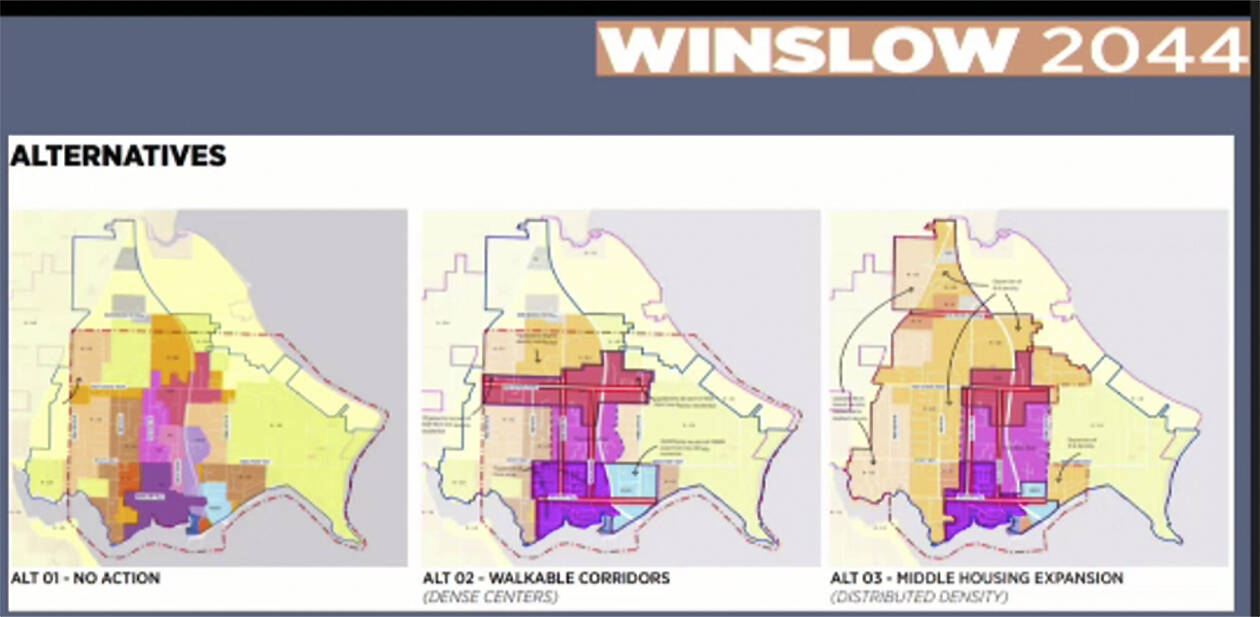Up or out? That is the question. The answer likely will be both.
There are three draft alternatives for growth in the Winslow Subarea Plan. One is to do nothing. Two is for taller buildings. Three is to expand the area around Winslow where growth can occur.
Bainbridge Island planning director Patty Charnas explained the options to the City Council Jan. 16 as the draft report heads to the environmental impact statement phase. “No one alternative is expected to win over another,” she said, adding the preferred alternative likely will be like in other jurisdictions such as Kitsap County, which is a combination of the latter two.
The EIS will address major issues like size and land use of the urban growth area; levels of capital improvements; and much more. She said the analysis in the EIS will look at the likely tradeoffs and impacts.
In Winslow listening workshops, participants listed as priorities housing, walkable open space, and diversity, equity and inclusion.
City attorney Jim Haney said it’s mandated to plan for housing for all income levels. “The statute is not one size fits all,” he said, adding environmental impacts and consequences will be considered.
Councilmember Leslie Schneider wanted to know what likely is going to happen. Schneider asked if going out with growth rather than up meant adding density in housing to the Neighborhood Centers of Rolling Bay and Lynwood and Island centers. She also asked how close would the city be if it continues to pursue affordable housing in places like the old police station.
Charnas said she has no way of knowing until the EIS is done.
“Let’s let the process work so we can get the answers to the puzzle,” Councilmember Brenda Fantroy-Johnson said.
Charnas told the council that the county is about 1 1/2 years ahead of BI in the process so it would be good for them to look at their EIS. Charnas said theirs has many of the same things the Winslow-Comp Plan EIS will have. It came up with the same three options for growth. But it involves more people and more area and more rezones than ours will, she said.
Fantroy-Johnson said she would look at that information, “So I can understand what’s going on here.”
Councilmember Clarence Moriwaki agreed about letting the process work. “This might be the biggest thing we do to determine what kind of community we will have in the future.” He said councilmembers all have their own opinions, but decisions should be made using facts and having honest conversations. For example, he said townspeople should not think that there instantly will be thousands of new people coming to the area. But the city has to plan for the opportunity for growth for the next few decades.
Mayor Joe Deets said affordable housing is their biggest challenge.
Charnas said the city doesn’t have deep pockets to build all the affordable housing needed, but there are many ways to accomplish that goal that the city has some control of. Once the EIS is done, everyone will know “what’s closer to reality. It’s premature to talk” about it now.
Councilmember Jon Quitslund said he would like to see a variety of housing available on BI. “I don’t want to see only single-family housing outside of Winslow or only multi-family in Winslow.” He said he would like to see housing of different heights and condominiums and apartments and even co-ops be a possibility.
Charnas said the mandates for the report are “humbling” because so much specific information is asked for. “It’s daunting a little. But every jurisdiction has to deal with it.”
Councilmember Ashley Mathews said she’s appreciated the public process and wants to know “what we can do to maintain this level of engagement.” She said it’s also been encouraging to see some new people participating, but she would like to see more people of color.



